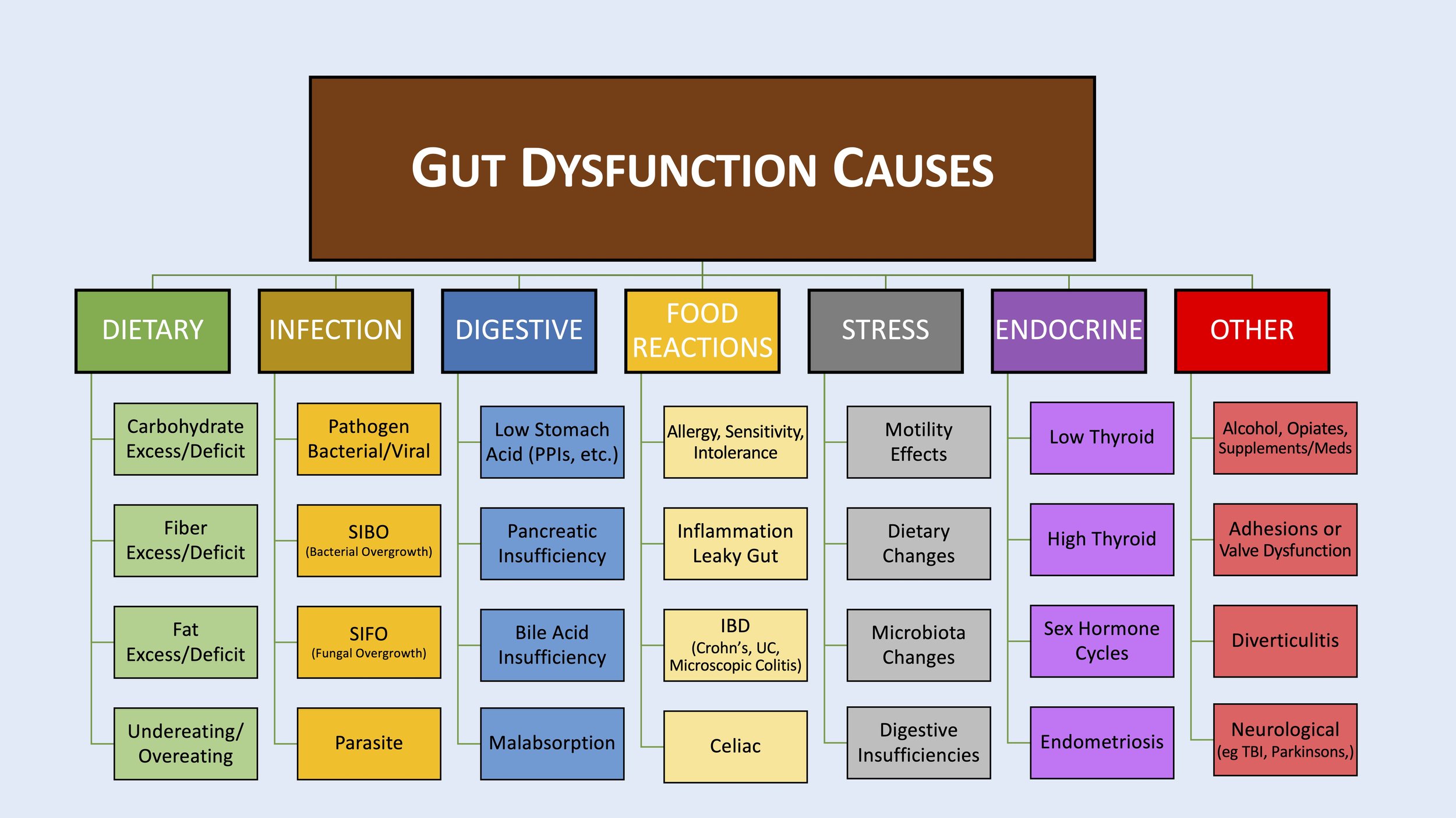Gut Health: A Functional Approach
If you are having digestive problems, you are not alone. The 2018 National GI Survey found that 61.0% of the 71,812 respondents had at least one digestive complaint issues in the past week. The most commonly reported symptoms were heartburn/reflux (30.9%), abdominal pain (24.8%), bloating (20.6%), diarrhea (20.2%), and constipation (19.7%). Less common symptoms were nausea/vomiting (9.5%), dysphagia (5.8%), and bowel incontinence (4.8%). 60% of the symptomatic respondents reported ≥2 concurrent symptoms.
Click here to take a Functional Gut Health Questionnaire.
Burden of Gastrointestinal Symptoms in the United States: Am J Gastroenterol. 2018 Nov; 113(11): 1701–1710.
Digestive diseases account for over 100 million ambulatory care visits annually in the U.S. Many more do not seek care at all. We can do better than this.
The human GI tract is an impressive 20-25 feet long. When flattened out, our GI tracts have 300 square meters of surface area! That’s the size of a double’s tennis court, and 200x more area than our skin. THis means that our GI track is, by far, our greatest exposure to the environment.
Let’s talk about the microbiome: that community of 100 trillion cells in and on our bodies, most of them in the gut. By comparison, an average male has only 35-40 trillion human cells. When you count the hundreds of trillions more mitochondrial cells (which are basically house-trained bacteria that make 99% of our body’s ATP energy), it’s fair to say that we are not a human hosting a microbiome, we are actually a microbiome hosting a human. With this in mind, it makes perfect sense to take great care with our microbiome.
When our guts play host to “unfriendly” microbes (bacteria, yeast & parasites), the result can be chronic immune system activation, leaky gut, and decreased gut surface area, and both GI and systemic inflammation.
A simple way to address many cases of GI distress is to take a probiotic. I like the Jarrow brand 50B CFU. If you buy three bottles, they are shipped in a well insulated cold pack.
Another way to bolster the good guys in your gut flora is to use the herb astragalus. Astragalus boosts your immunity to both bacterial and viral infections and has some direct effects on GI flora by promoting Lactobacillus and discouraging some of the less desirable bacterial residents.
Modern stressors of noise, traffic, overpopulation, and a constant barrage of phone pings and email are also disruptive to our digestion. One of the primary reasons for this is that the body reacts to these stressors by diverting energy away from our digestive organs and the metabolically expensive hydrochloric acid (HCl), pepsin, and pancreatic enzymes (protease, amylase, lipase, etc.). One way we can begin to get our digestion back on track is to supplement HCl and pancreatic enzymes with our meals.
Stress, NSAIDS, acid blockers, processed food, pesticides are all things that can cause gastrointestinal inflammation. This makes the gut “leaky” and allows food, foreign chemicals and microbiome proteins to enter the blood stream where the immune system does its best to protect you from these unexpected invaders. The immune system is quite thorough, often too thorough. Prolonged GI immune activation is believed to be behind the development of IBD and autoimmune diseases.
Many patients with Gastro-esophageal reflux or GERD (i.e. heartburn) are told to take antacids like Rolaids or Tums or proton pump inhibitors (Prilosec, Prevacid and Nexium) or H2-blockers (e.g. Zantac, Pepcid and Tagamet). Unfortunately, all of these cover up symptoms and make the underlying problem worse. In most cases, the solution to GERD is avoiding adverse food reactions (allergies, intolerances, or sensitivities) and actually increasing the amount of HCl and active enzymes in your stomach and intestines.
What can be done about the damage that stress, and improper digestion causes? My first-line suggestion is DGL (Deglycyrrhizinated Licorice). DGL lozenges are really effective at soothing an esophagus, stomach and duodenum that have been beaten up by acid or adverse food reactions.
Aloe Vera Gel is also very effective at soothing an enflamed GI tract. Aloe Vera’s constituent mucopolysaccharides, also known as glycosaminoglycans (GAGs), are thought to be its active components. Scientific studies have indicated that Aloe can help to support the body’s own healing processes. In addition, Aloe Vera has been shown to support a healthy digestive system. NOW Foods makes a 200x concentrated soft gel capsule.
Zinc, Mastic gum, and slippery elm are three other agents that can soothe repair damage from gut inflammation and maldigestion. NOW foods makes a product with therapeutic amounts of all three of these agents: Uletrol.
Leaky gut is the loss of tight junction integrity and increased intestinal permeability to larger molecules in the GI tract. Leaky gut is associated with the pathogenesis of inflammatory bowel disease (IBD), irritable bowel syndrome (IBS), celiac disease and infectious enterocolitis. The specialized junctional complexes between cells lining your gut are called “tight junctions”, and these provide the intestinal epithelial barrier function. Mucosal protective factors such as growth factors and nutrients preserve the gut barrier integrity and are beneficial in the treatment of various gastrointestinal diseases.
L-Glutamine the most abundant amino acid in blood plays a vital role in the maintenance of mucosal integrity. Glutamine is rapidly consumed in the cells lining your gut–especially if there is some trauma, inflammation, stress, or infection. In the small bowel mucosa, glutamine is a unique nutrient providing fuel for metabolism, regulating cell proliferation, repair and maintaining the gut barrier functions. For anyone experiencing IBD, IBS, food allergies, or food sensitivities, autoimmune diseases it is well worth taking 5g of L-glutamine powder in water 3x/day between meals. Bought in bulk, it costs less than $0.20 per serving.
Of course, we can not ignore our diets. Processed are considered “normal”, but to our bodies, many amount to nothing short of an alien encounter. In humanity’s 200,000 year history, farming is a surprisingly new development. About 11,000 years ago, agriculture started popping up around the globe in Asia, South America, Europe and the Middle East. This means that for ~90% of our development as a species, humans were not eating significant amounts of grains or or farmed foods. Processed foods with refined sugars, refined grains, preservatives, artificial flavors, etc. are only 50-75 years old. This means that, at most, 99.3% of humanity’s evolution was apart from any processed food.
Historically speaking, the hominids from which humanity evolved are ~5 million years old. This makes processed food 99.999% foreign to us historically. Fast forward to the present. We all are living in a society where processed food has become the bizarre “normal”. So It’s no wonder that digestive diseases are so pervasive.
Along with grains and processed foods streaming into the food supply, humanity developed the “modern epidemics” including: obesity, diabetes, heart disease, cancers, Alzheimer’s, Parkinson’s, ADD, anxiety, depression, insomnia, indigestion, irritable bowel syndrome, fatigue, headaches, and a host of cancers and autoimmune diseases. These modern epidemics have become so pervasive that conventional medicine seems to consider them a normal or inevitable part of life and aging.
A growing group of Functional and Naturopathic clinicians are forwarding the idea that the path back to optimal health is largely paved by a return to a natural, whole-foods diet. Although taking this step can represent a drastic shift for many people, it is really a return to our true nature.
It should not really be surprising that although modern processed foods are inherently foreign and often very problematic. No matter what you may be suffering from, returning to a more natural human diet is, by far, probably the most important thing you can do to support your return to natural health. Food is medicine.
We now know that many cases of autoimmune diseases get started with leaky gut. The connection between your gut health and immune function is now well known. For starters, the majority of of your body’s immune cells (50%-70% ) live in your gut. When leaky gut allows larger food molecules through the intestines, that’s when your immune system often starts reacting badly to foods. Once activated, your immune system can become like a bad guard dog that not only attacks the food, microbiome and chemicals in your diet, it attacks the gut itself causing gut inflammation which not only decreases your ability to absorb foods, it further promotes leaky gut, new food sensitivities, systemic inflammation and dramatically increases the risk of autoimmune diseases.
All this is the backdrop for a key primary Functional and Naturopathic intervention: The Elimination Diet. Elimination Diets can be done in many ways, but they always involve removing foods that are potentially contributing to an individual patient’s state of disease for 4-12 weeks, and then reintroducing them one at a time while watching for flareups. A “complete” elimination diet involves reducing food options to a short list of whole foods considered least likely to be problematic.
In my practice, when I think that an adverse reaction to food (ARF) may be underlying a patient’s symptoms, I often find it most effective to select a more “targeted” elimination of one or more the most likely dietary exacerbates: Wheat/gluten, dairy, sugar, soy, corn, and food additives and preservatives, pesticides of any kind and perhaps the nightshades (tomatoes, peppers, potatoes).
Another way to test for adverse reactions to food is to do a blood food sensitivity test. A true “allergy” to food is mediated by IgE immunoglobulins. These are often, but not always fairly obvious and severe IgE reactions are the classic anaphylaxis: hives, and airway closure requiring a shot of epinephrine. Food “sensitivity” is mediated by the less perilous IgG immunoglobulin, and other more difficult to detect immune reactions to food. Serum IgG testing is an easy way to survey your blood for 90+ foods at once for ~$200. Many patients find this a excellent way to target a trial of an elimination diet.
Here’s how it works: Do eliminate the suspected foods for 4-12 weeks and then sequentially “challenge” the eliminated foods one at a time for a few days each while watching for a return or exacerbation of symptoms such as: headache, brain fog, joint pain, acne, skin rash, acid reflux, loose stools, IBS, anxiety, disturbed sleep, etc. These conditions are all exacerbated by an over-activated immune system caused by the foreign proteins and chemicals in grains and processed foods.
Back to the bugs. One of the other primary interventions I use with patients is Gut probiotics and fermented foods. I am especially likely to recommend probiotics and fermented foods to patients that have more serious gut dysfunction, systemic inflammation, autoimmunity, a weak immune system, a history of a standard American diet (SAD) or taking frequent courses of antibiotics.
For patients with concerted GI issues, I may order a specialized stool test called a Complete Stool Analysis & Parasitology (CSAP). For ~$320, you can learn an awesome amount about your many aspects of digestion and the community of microbes (both good and bad) living inside your amazing and vitally important GI tract. A more economical option that focusses on identifying problematic viruses, bacteria yeast/fungus and parasites Culture, PCR + Parasitology for $170.
The take-home point is that lots of things can harm your gut function, but if we eat appropriate foods, treat infections, ensure good digestion and make sure your microbiome is optimal, we can prevent and reverse many if not most health problems today. I you are having gut symptoms, don’t wait. Contact us with your questions or make an appointment.


